
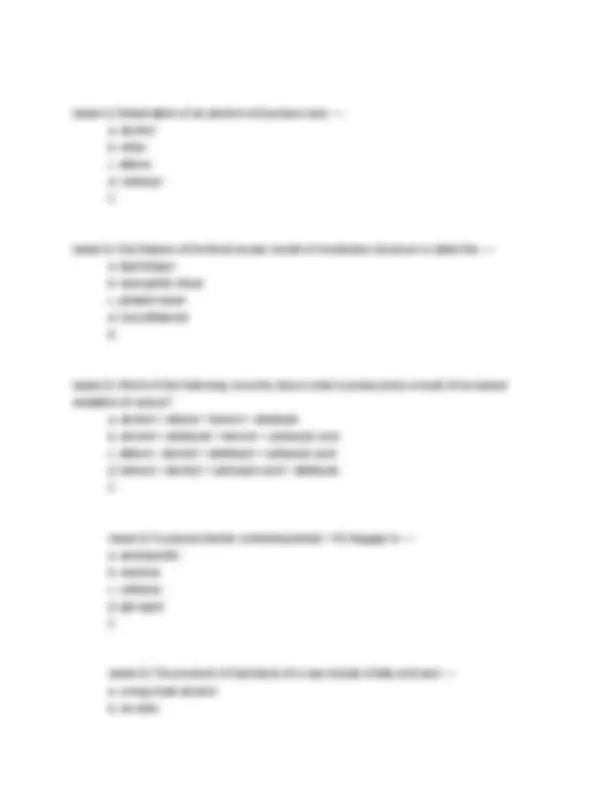

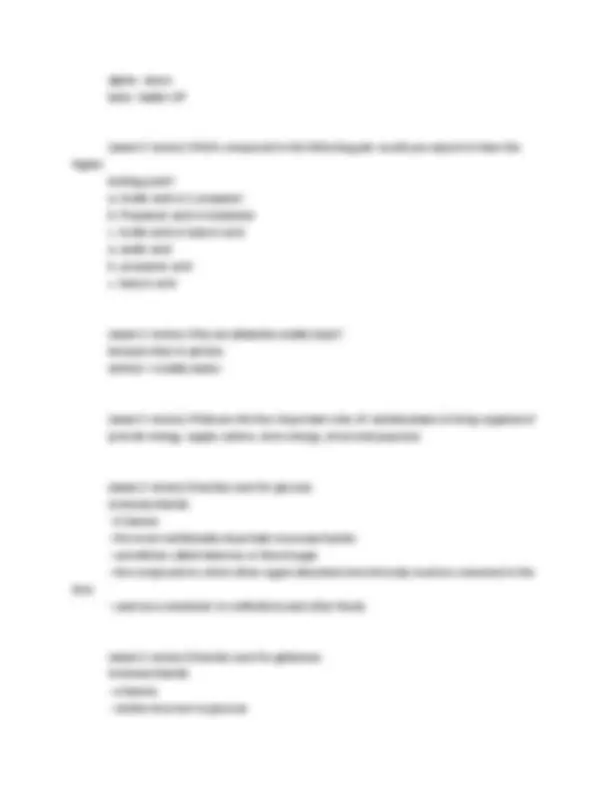





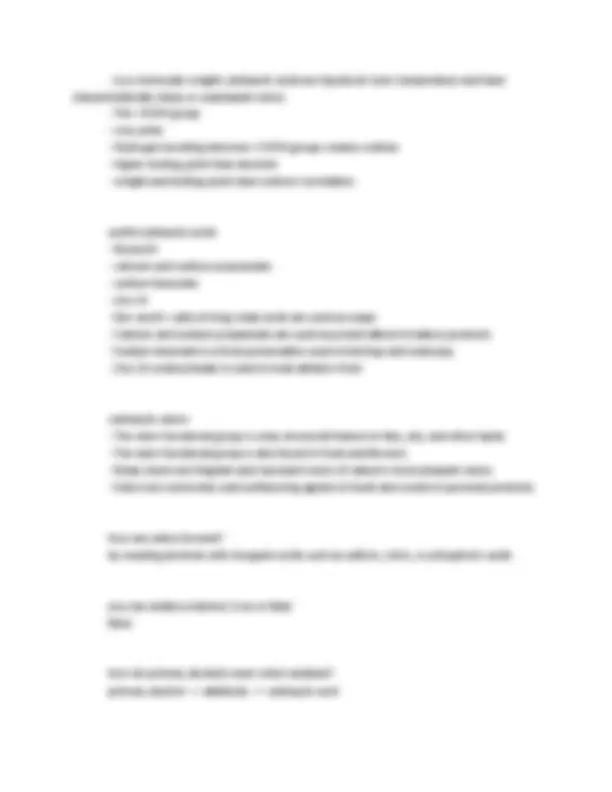







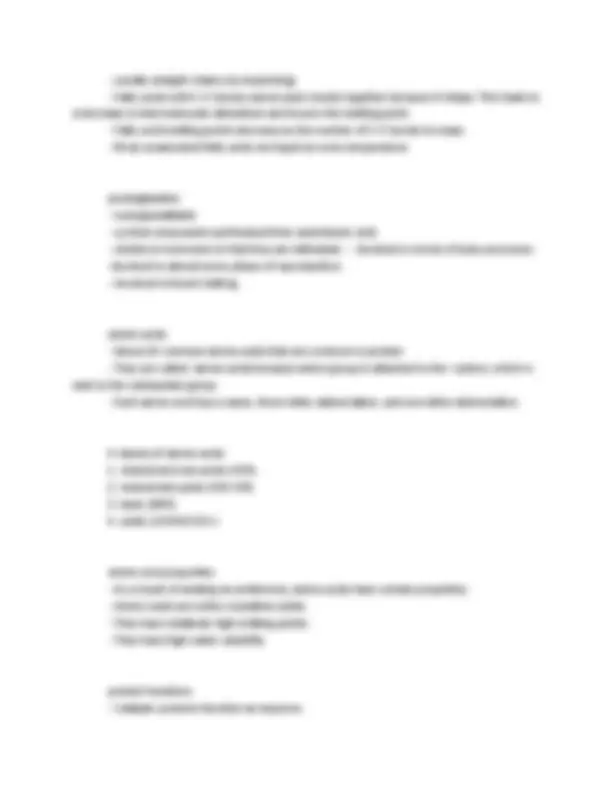

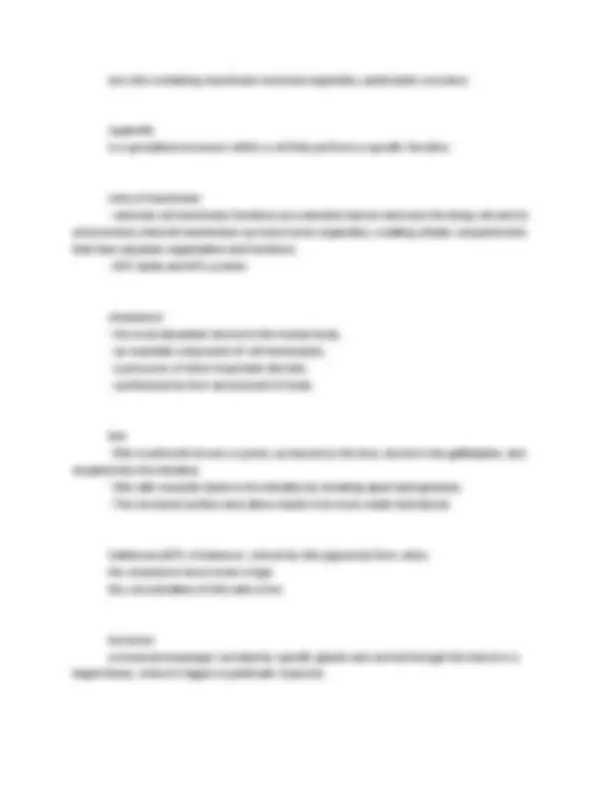



Study with the several resources on Docsity

Earn points by helping other students or get them with a premium plan


Prepare for your exams
Study with the several resources on Docsity

Earn points to download
Earn points by helping other students or get them with a premium plan
Community
Ask the community for help and clear up your study doubts
Discover the best universities in your country according to Docsity users
Free resources
Download our free guides on studying techniques, anxiety management strategies, and thesis advice from Docsity tutors
CHEM 1020 FINAL EXAM 2025 LATEST SPRING SUMMER SEMESTER INTRODUCTION TO CHEMISTRY AND BIOCHEMISTRY UC (exam 1) Three physical properties shown below beside different alkane series. Which of the series is (are) lister on the order of increase (lowest to highest) for the corresponding property? a. density: C4H10 < C5H12 < C8H18 b. melting point: C8H18 < C5H12 < C4H10 c. biking point: C5H12 < C4H10 < C8H18 d. all are correctly ranked A; density, melting poing, and boiling point increase as chain length increases (exam 1) Draw the structural formula for 1-bromo-2,2-dimethylpropane. look at question 2 on exam 1 for answer
Typology: Exams
1 / 28

This page cannot be seen from the preview
Don't miss anything!





















(exam 1) Three physical properties shown below beside different alkane series. Which of the series is (are) lister on the order of increase (lowest to highest) for the corresponding property? a. density: C4H10 < C5H12 < C8H b. melting point: C8H18 < C5H12 < C4H c. biking point: C5H12 < C4H10 < C8H d. all are correctly ranked A; density, melting poing, and boiling point increase as chain length increases (exam 1) Draw the structural formula for 1-bromo-2,2-dimethylpropane. look at question 2 on exam 1 for answer (exam 1) What is a major difference between inorganic and organic compounds? a. there are many more inorganic compounds than organic compounds b. organic compounds contain carbon; few inorganic compounds do c. organic compounds are never ionic d. organic compounds tend to be more polar than inorganic compounds B (exam 1) When the compound 1,2-dimethylcyclopropane has CH3 on both sides pointing in the same direction, the compound is? a. cis b. trans c. either cis or trans d. neither cir nor trans A; only in a 3d shape can they be cis or trans
(exam 1) Isomers always have the same molecular formula. a. true b. false A; but different arrangements (exam 1) What type of hybridization is associated with alkyne bonding? a. sp b. sp c. sp d. sp A; sp2 - alkene, sp3 - alkane (exam 1) What conditions must be used to carry out the following reaction? 2CH3CH2CH2-OH ---> CH3CH2-O-CH2CH3 + H2O a. H2SO4, 180C b. H2SO4, 140C c. HCl d. NaOH B; 140 degrees-ether, 180 degrees-alkane (exam 1) Which of the following will react with Tollens' reagent? a. aldehyde b. ketone c. alcohol A (exam 1) Which of the following compounds would you expect to be foul smelling? a. CH3CH2CH2OH b. CH3CH2CH2SH c. CH3CH2CH2CH d. CH3CH2CH2CHO B; SH means thiol-thiols are smelly
c. glycerol d. more than one response is correct A (exam 2) a functional group present in fats is a(n) ---- a. aldehyde b. carboxylic acid c. ester d. alcohol C (worksheet 1) list the following prefixes for 1 - 10 meth, eth, prop, but, pent, hex, kept, oct, non, dec (worksheet 7) Where will you find a - CHO group? aldehyde (worksheet 7) Which OH group determines whether a sugar is D or L? the penultimate carbon (worksheet 7) What is a chiral carbon? C with 4 different things attached to it (worksheet 7) What is an enantiomer? a mirror image (worksheet 7) What is an anomeric carbon? carbon attached to 2 oxygens (worksheet 7) Which direction do alpha and beta point?
alpha - down beta - batter UP (exam 2 review) Which compound in the following pair would you expect to have the higher boiling point? a. Acetic acid or 1-propanol b. Propanoic acid or butanone c. Acetic acid or butyric acid a. acetic acid b. propanoic acid c. butyric acid (exam 2 review) Why are alkaloids weakly basic? because they're amines amines = weakly basics (exam 2 review) What are the four important roles of carbohydrates in living organisms? provide energy, supply carbon, store energy, structural purposes (exam 2 review) Describe uses for glucose. monosaccharide
(exam 2 review) Describe the four general characteristics of fatty acids. straight chained carboxylic acid, 10-20 carbons, even number of carbons, saturated/unsaturated (exam 2 review) Similarities and differences in fats and oils. both triglycerides fats more saturated than oils fats solid; oils liquid organic vs. inorganic
stereo isomers are compounds with the same structural formula but different spatial arrangements of atoms geometric isomers are molecules with restricted rotation around C-C bonds that differ in the three- dimensional arrangements of their atoms in space and not in the order of linkage of atoms saturated hydrocarbon only single bonds - alkane unsaturated hydrocarbon more than one bond - alkene, alkyne, and aromatic conformation The different arrangements of atoms in space achieved by rotation about single bonds; these are not isomers common alkane groups
a double bond alkynes tripe bond aromatic alternations of bonds, ring form physical properties of alkene
uses of phenols disinfectant and antioxidants in food properties of ethers
tollens reagent oxidizes aldehydes but not ketones; silver ions benedict reagent oxidizes aldehydes as well, but not ketones Which is more stable? cyclic hemiacetals and hemiketals or open-chains? Cyclic hemiacetals and hemiketals formaldehyde
what forms when a secondary alcohol gets oxidized? a ketone forms what forms when a tertiary alcohol gets oxidized? nothing; they do not react what happens when a ketone gets oxidized? nothing; they do not react what happens to an aldehyde with the addition of hydrogen? a primary alcohol is produced what happens to a ketone with the addition of hydrogen? a secondary alcohol is produced what happens to an aldehyde with an addition of alcohol? forms a hemiacetal and then acetal what happens to a ketone with an addition of alcohol? forms a hemiketal and then a ketal physical properties of amine
and reaches the fetus. quinine used to treat malaria atropine